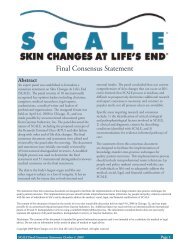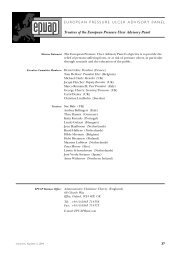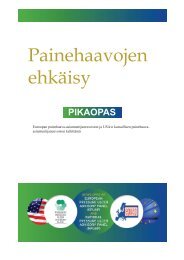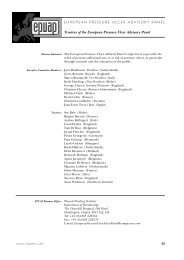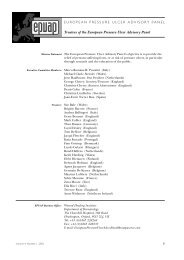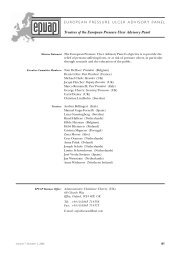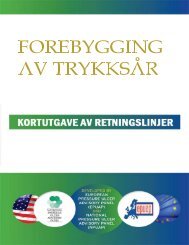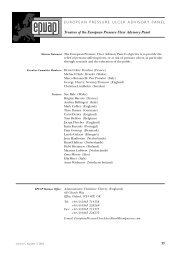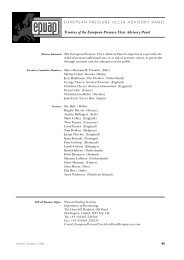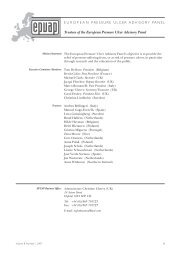EPUAP Review 10.1.indd - European Pressure Ulcer Advisory Panel
EPUAP Review 10.1.indd - European Pressure Ulcer Advisory Panel
EPUAP Review 10.1.indd - European Pressure Ulcer Advisory Panel
You also want an ePaper? Increase the reach of your titles
YUMPU automatically turns print PDFs into web optimized ePapers that Google loves.
EUROPEAN PRESSURE ULCER ADVISORY PANEL<br />
mattresses. The repositioning frequency depends on the pressure<br />
redistributing features of the support surface.<br />
REPOSITIONING TECHNIQUE<br />
REPOSITIONING THE<br />
SEATED INDIVIDUAL<br />
REPOSITIONING DOCUMENTATION<br />
3. Repositioning will maintain the individual’s comfort, dignity and functional<br />
ability. (Strength of Evidence = C)<br />
3.1. Reposition the individual in such a way that pressure is relieved<br />
or redistributed. (Strength of Evidence = C)<br />
3.2. Avoid subjecting the skin to pressure and shear forces. (Strength<br />
of Evidence = C)<br />
3.3. Use transfer aids to reduce friction and shear. Lift, don’t drag<br />
the individual while repositioning. (Strength of Evidence = C)<br />
3.4. Avoid positioning the individual directly onto medical devices,<br />
such as tubes or drainage systems. (Strength of Evidence = C)<br />
3.5. Avoid positioning the individual on bony prominences with existing<br />
non-blanchable erythema. (Strength of Evidence = C)<br />
3.6. Repositioning should be undertaken using the 30 degree semi<br />
Fowler position or the prone position and the 30 degree-tilted side lying<br />
position (alternately right side, back, left side) if the individual can<br />
tolerate this position and the medical condition allows. Avoid postures<br />
that increase pressure, such as the Fowler’s over 30 degree or the 90<br />
degree side lying position, or the semi-recumbent position. (Strength of<br />
Evidence = C)<br />
3.7. If sitting in bed is necessary, avoid head of bed elevation and a<br />
slouched position that places pressure and shear on the sacrum and<br />
coccyx. (Strength of Evidence = C)<br />
4. Position the individual so as to maintain their full range of activities.<br />
(Strength of Evidence = C)<br />
This may be a complex process, for example, in an armchair which tilts<br />
back, the use of a foot rest with the heels offloaded may be a suitable<br />
position in terms of pressure redistribution but may impede transfer to<br />
and from the chair.<br />
4.1. Select a posture that is acceptable for the individual and minimizes<br />
the pressures and shear exerted on the skin and soft tissues.<br />
(Strength of Evidence = C)<br />
4.2. Place the feet of the individual on a foot stool or foot rest when<br />
the feet do not reach the floor. (Strength of Evidence = C)<br />
When the feet do not rest on the floor, the body slides forward out of<br />
the chair. Foot rest height should be chosen to slightly flex the pelvis<br />
forward by positioning the thighs slightly less than horizontal.<br />
4.3. Limit the time an individual spends seated in a chair without<br />
pressure relief. (Strength of Evidence = B)<br />
When an individual is seated in a chair, the weight of the body causes<br />
the greatest exposure to pressure to occur over the ischial tuberosities.<br />
As the loaded area is relatively small, the pressure will be high, therefore,<br />
without pressure relief, a pressure ulcer will occur very quickly.<br />
5. Record repositioning regimes, specifying the frequency, position<br />
adopted and the evaluation of the outcome of the repositioning regime.<br />
(Strength of Evidence = C)<br />
10<br />
Volume 10, Number 1, 2009



